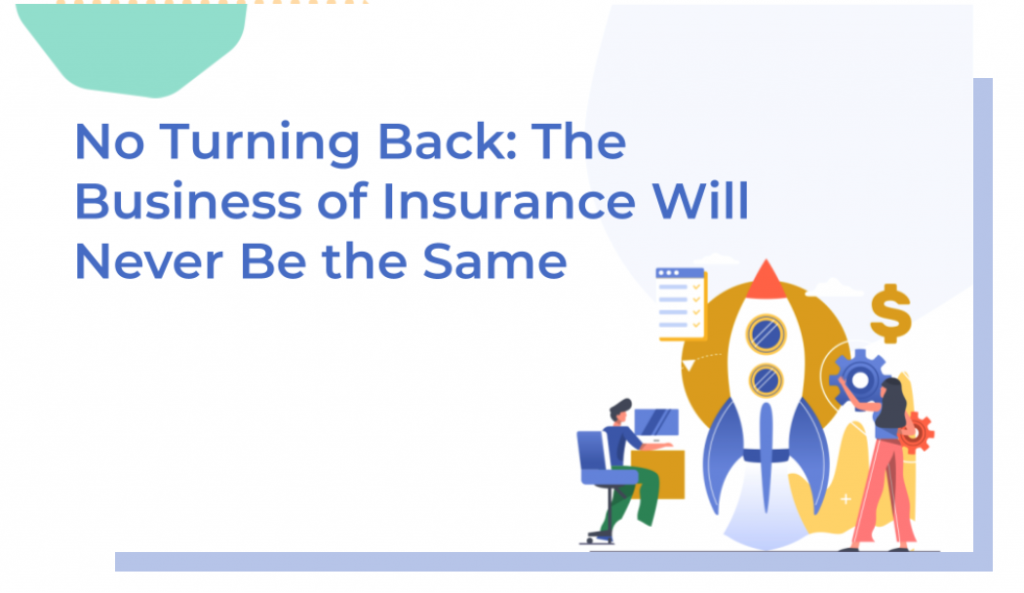No Turning Back

As we head into the holidays after a long and difficult year, I’ve been thinking about what a remarkable year it has been as well.
Remarkable, because when it comes to the business of insurance, our industry made more digital progress in one year than any of us could have predicted! Multi-year digital transformation roadmaps got dramatically compressed — and in some cases even tossed out — as everyone’s attention turned to business continuity. And to continue doing business, the insurance industry had to make significant and widespread changes, all the way from product development to delivery.
At the same time, the InsurTech market exploded as agile, new digital-native companies hit their stride. Lemonade went public, then Duck Creek Technologies and Root Insurance. Unicorns continued to thrive as companies like WeFox Group, Oscar Health, Hippo, and Next Insurance raised millions upon millions of dollars, building out their war chests.
Consumers Have Choices
Incumbent insurers are no longer the only game in town. A short time ago, there weren’t many serious contenders in the InsurTech startup ranks, but this is no longer true. In almost every segment, there are a growing handful of tech-forward players that are “reimagining” the insurance business with consumer-friendly, digital experiences, including automated underwriting and digital policy delivery, among others.
And they aren’t going away.
Consider this a wakeup call for carriers that sell through advisors and agents, too. You may not be planning to provide a direct-to-consumer sales channel soon, but you can’t discount the customer experience offered by your brand today. If that experience is only ‘adequate’ – in the way you might tolerate a website that looks like it was built in the 1990s – and you expect customer loyalty to win the day, prepare to be disappointed.
Moreover, with low interest rates and other economic headwinds, customer acquisition costs are under pressure. A great digital experience that allows you to identify the best prospects for advisor sales, while also providing online options for simpler sales, can help you improve on both fronts. But this isn’t a matter of ‘nice to have’ – it’s ‘a must.’ Digital tools have proven themselves to be key to increasing sales volume and efficiency at a lower total cost of acquisition and faster speed to policy.
While my head, heart and distribution platform are firmly in the 2020s, I can’t help but think the Blockbuster/Netflix analogy still holds true for the insurance industry. Dismissing disruptors today – the Lemonade’s, Metromile’s, and Hippo’s of the insurance world – is akin to Blockbuster dismissing online DVD rentals, then streaming content, while Netflix eats its lunch.
Are you Blockbuster or Netflix?
Insurers Have Choices
In the recent past, it wasn’t completely unreasonable for an insurer to build out its own digital capabilities, often with the help of high-priced consultants. Technology providers offered “solutions” to anything and everything, and there was a tendency to overcomplicate technology projects in an attempt to “boil the ocean.” With no real competition or sense of urgency, perfection soon became the enemy of the good.
Then the world shut down thanks to the coronavirus pandemic, and the only way to continue doing business was to tackle problems rapidly, one by one, until a reasonable workaround could be implemented. Forget perfect, as long as it worked – and we all found ways of making our businesses work in 2020 by making choices we never imagined we’d make this way.
Ironically, when we have no choice, we can do just about anything…we think we have no good choices until we have to make one work.
My point is, with a maturing InsurTech market — as evidenced by all the market activity this past year – once nascent technology, automated underwriting for example, is now ready for prime time, providing carriers with more choices than ever before.
Lessons from 2020
- Just do it (with thanks to Nike): Odds are that your business has a couple of points of friction in the sales and distribution process that you were able to fix with a Band-Aid when you had to. Don’t lose that sense of urgency as we head into 2021 – finish what you started and fix it for real.
- Tackle the tech to-do list one project at a time: You already know there isn’t a silver bullet, but you continue to stand by legacy tech investments because change is scary – but, remember, not as scary as slowly going out of business.
- Perfection is the enemy of the good: my colleague, Arach Tchoupani, wrote an article recently about how we (humans) have a tendency to solve problems that have already been solved – his example was ecommerce. It’s time to stop reinventing the wheel.
- Time is a luxury you don’t have: when the pandemic upended traditional ways of doing business, the insurance industry adjusted more quickly than anyone thought possible. So, the time is now to re-evaluate your project roadmaps to reflect the reality of time – it’s not unlimited. And, in the time it takes to give yourself a pat on the back for being so nimble in 2020, some InsurTech, or worse yet, Google/Amazon or other big-tech behemoth, is coming to eat your lunch, until there is none left.
By all accounts, 2021 should be a “better” year – better for humanity, better for business, and better for insurers. That said, we know life happens fast, and we’re never as ready as we want to be to meet the challenges ahead. Let’s take the head start we gained in 2020 and make the most of it in the coming year.

